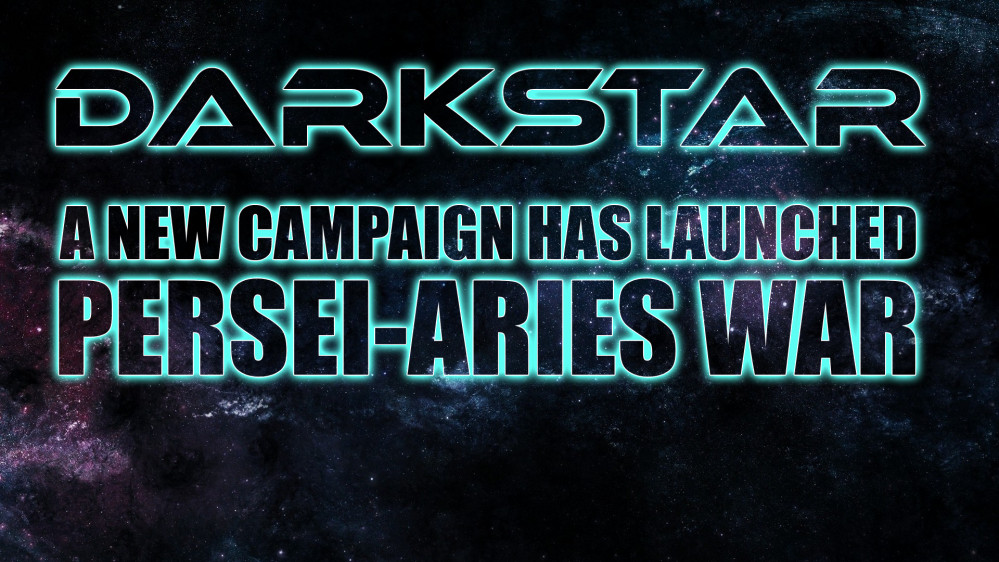
Persei-Aries War Resumes
Task Force Oriskany DEFEATED!
FROM: UNITED NATIONS REGIONAL COLONIAL CENTER
02:30 SOL GMT, 15 NOVEMBER 2520
BREAKAUTH: 181072.18J
CLEARANCE: SECRET (NATIONAL)
**UNITED NATIONS COMMUNIQUE**
A second battle has been reported in the rapidly-developing Hercules Crisis. It seems the United States has now entered the war, honoring new treaties with the Holy Russian Empire, which opened hostilities with the United Kingdom and Japan last month in the Zeta Hercules system (Kyokko Bijin – “Beauty of Dawn”) We can now confirm that TASK FORCE ORISKANY has engaged in open combat in the 72 Hercules system (Krasnaya Nadezhda – “Red Hope”), apparently to intercept a British and Japanese raiding force against the Russians in retaliation for their incursion in Kyokko Bijin.
The American intervention was a startling one, given the distance of their closest base at Vega (Alpha Lyra) some thirty light-years away. But during the recent Xi Scorpio and Scorpion’s Tail Wars, Task Force Oriskany has built a record of incredibly fast superluminal jumps, their ships apparently fitted with heavily-upgraded Darkstar drives. Thus, when the British heavy cruiser HMS Agamemnon (escorted by the destroyer HMS Sheffield), alongside the Japanese light cruiser Sendai Byo (escorted by the frigates Urakaze and Sakito) emerged from their Darkstar waves in the outer protoplanetary debris field of the Russian-held 72 Hercules system, they found the much smaller American force just arriving as well, along with a Russian K-56 class torpedo corvette. The two forces will meet at Molodoy Burunduk (Baby Chipmunk), a Mars-sized planet far out on the outer fringe of the 72 Hercules system.
Given that the British and Japanese (known as the “Renkei Alliance”) launched this operation as a raid, and that the Japanese cannot fully commit to a “hit and stay” assault with Russian cruiser somewhere in their own Kyokko Bijin system, and that the Americans are clearly defending someone else’s star system, this wasn’t a terribly hard-fought action by either side. While we are informed that losses on both sides were relatively light, and that fighting was generally cautious, reserved, and measured, it was a major action nonetheless, especially since it heralds the entry of the United States into the war.
The Hercules Crisis is over. The Third Hercules War has begun.
Americans and Russians: @oriskany
British: @damon
Japanese: @rasmus
Played: Saturday, October 26, 2019
Engagement 02: Interdiction of Cruiser Raid, Molodoy Burunduk (Baby Chipmunk), Kranaya Nadhezda system (72 Hercules), 15 November 2520
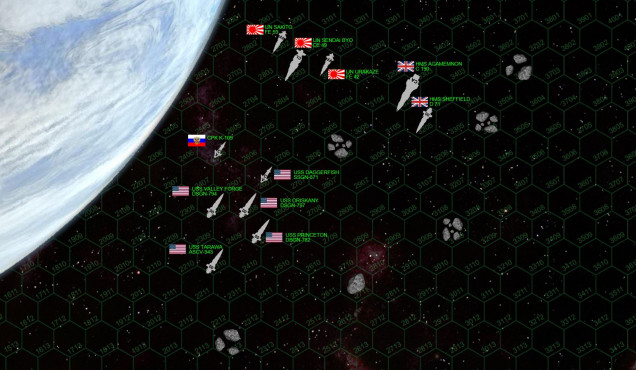 The Americans are outweighed here by as much as three-to-one. Task Force Oriskany has no ship heavier than 48,000 tons (the three Valcour-class destroyers USS Oriskany, Princeton, and Valley Forge), along with the Buford-class light carrier USS Tarawa (technically a USMC planetary assault ship) and the torpedo corvette USS Daggerfish. The “Renkei Alliance” force is headed up by the Trafalgar class heavy cruiser HMS Agamemnon, backed up by the light cruiser IJN Senai Byo, destroyer HMS Sheffield, and frigates IJN Urakaze and IJN Sakito. But what the Americans have is experience and a huge number of upgrades. These are veteran ships and crews, the Marine fighter group aboard the Tarawa is among the best in Known Space (VMSA-309, the Tigersharks). But can that experience and those upgrades really overcome such a vastly more powerful force? The planet is measured out to be Mars-sized (radius 19 hexes = diameter of 6800 kilometers). Usual gravity rules apply.
The Americans are outweighed here by as much as three-to-one. Task Force Oriskany has no ship heavier than 48,000 tons (the three Valcour-class destroyers USS Oriskany, Princeton, and Valley Forge), along with the Buford-class light carrier USS Tarawa (technically a USMC planetary assault ship) and the torpedo corvette USS Daggerfish. The “Renkei Alliance” force is headed up by the Trafalgar class heavy cruiser HMS Agamemnon, backed up by the light cruiser IJN Senai Byo, destroyer HMS Sheffield, and frigates IJN Urakaze and IJN Sakito. But what the Americans have is experience and a huge number of upgrades. These are veteran ships and crews, the Marine fighter group aboard the Tarawa is among the best in Known Space (VMSA-309, the Tigersharks). But can that experience and those upgrades really overcome such a vastly more powerful force? The planet is measured out to be Mars-sized (radius 19 hexes = diameter of 6800 kilometers). Usual gravity rules apply. Both sides make their approach. The Americans come on incredibly fast, determined to make the most of their smaller ships’ advantages in speed and maneuverability. The Marine fighters launch from the Tarawa, while all American and Russian ships release a full frontal spread of Mk 48 and P-500 torpedoes. The small guns of the Japanese frigates cannot reach the Americans, while the Agamemnon, Sendai Byo, and Sheffield try to ping at the Tarawa with long-ranged weapons. Almost everything misses, however, thanks to powerfully-upgraded ECM and gravitic shielding.
Both sides make their approach. The Americans come on incredibly fast, determined to make the most of their smaller ships’ advantages in speed and maneuverability. The Marine fighters launch from the Tarawa, while all American and Russian ships release a full frontal spread of Mk 48 and P-500 torpedoes. The small guns of the Japanese frigates cannot reach the Americans, while the Agamemnon, Sendai Byo, and Sheffield try to ping at the Tarawa with long-ranged weapons. Almost everything misses, however, thanks to powerfully-upgraded ECM and gravitic shielding. The British and Japanese S-Turn away from the Americans trying to keep their distance where their accurate (and heavier guns) will prove more of an advantage. They’re also hoping to knock out at least one American or Russian ship to thin out that incoming wave of torpedoes. The Tarawa has now finished launching her Marine strike group, “Avenger” bombers and “Corsair” fighters howling in behind the Mk 48s and P-500s. The Americans continue to snake further around the British and Japanese flank, clearly hoping for attacks on vulnerable engines and reactors, and to perhaps force the British and Japanese to turn TOWARDS the planet to engage them. This is always a dangerous move, as a loss of power means the ship is a death-dive toward the planet’s surface. That said, the Americans must also be careful now that the Japanese and British are beginning to maneuver among the debris field of this dwarf planet’s failed moon.
The British and Japanese S-Turn away from the Americans trying to keep their distance where their accurate (and heavier guns) will prove more of an advantage. They’re also hoping to knock out at least one American or Russian ship to thin out that incoming wave of torpedoes. The Tarawa has now finished launching her Marine strike group, “Avenger” bombers and “Corsair” fighters howling in behind the Mk 48s and P-500s. The Americans continue to snake further around the British and Japanese flank, clearly hoping for attacks on vulnerable engines and reactors, and to perhaps force the British and Japanese to turn TOWARDS the planet to engage them. This is always a dangerous move, as a loss of power means the ship is a death-dive toward the planet’s surface. That said, the Americans must also be careful now that the Japanese and British are beginning to maneuver among the debris field of this dwarf planet’s failed moon. 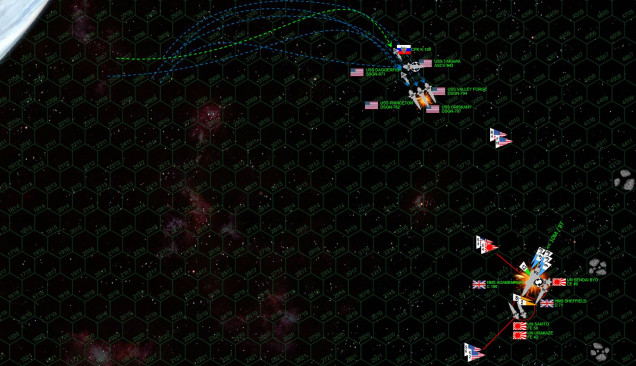 Turn Three, where the Americans finally pounce. With a sharp turn to starboard, they make high speed straight toward the Japanese and British. Their torpedoes make their terminal attack runs at the heavy cruiser Agamemnon, but there’s a crucial flaw in the attack. The slower Russian torpedoes are JUST out of the required range to attack the STERN of the Agamemnon, and instead hit the cruiser’s starboard quarter. This lack of coordination means that the combined torpedo strike isn’t quite enough to destroy the Agamemnon’s engineering sections and cripple the ship, even with the Marine bomber and fighter missile strike. That said, the Agamemnon is GRAVELY damaged, losing two sensor suites and almost blinded. The Japanese and British, meanwhile, pour a complete broadside into the USS Oriskany at just 1800 kilometers, every single gun on all five ships opening fire on one target. Although the bridge and forward magazine is hit, “The Lady O” does not lose power. Casualties are heavy, however, and Captain Matthew Spencer is compelled to order his legendary ship to break off the action.
Turn Three, where the Americans finally pounce. With a sharp turn to starboard, they make high speed straight toward the Japanese and British. Their torpedoes make their terminal attack runs at the heavy cruiser Agamemnon, but there’s a crucial flaw in the attack. The slower Russian torpedoes are JUST out of the required range to attack the STERN of the Agamemnon, and instead hit the cruiser’s starboard quarter. This lack of coordination means that the combined torpedo strike isn’t quite enough to destroy the Agamemnon’s engineering sections and cripple the ship, even with the Marine bomber and fighter missile strike. That said, the Agamemnon is GRAVELY damaged, losing two sensor suites and almost blinded. The Japanese and British, meanwhile, pour a complete broadside into the USS Oriskany at just 1800 kilometers, every single gun on all five ships opening fire on one target. Although the bridge and forward magazine is hit, “The Lady O” does not lose power. Casualties are heavy, however, and Captain Matthew Spencer is compelled to order his legendary ship to break off the action. 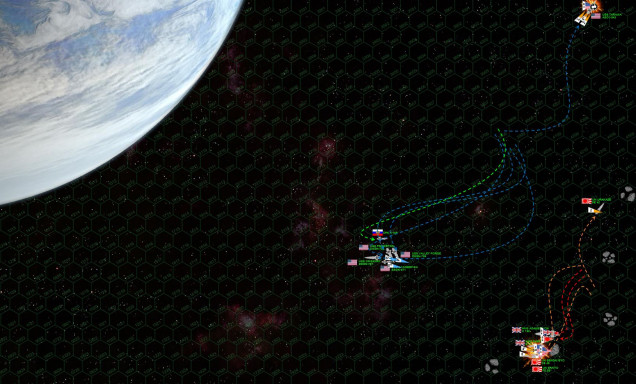 Spencer realizes now that he’s missed his first and best chance to win this battle. With just three destroyers, there’s no way he can win in a gunnery duel with a heavy cruiser, a light cruiser, a destroyer, and two frigates. As Oriskany heaves out of harm’s way, the Valley Forge and Princeton move to cover her. Daggerfish and K-109 sling out more torpedoes, hoping that just maybe a second torpedo strike just might cripple the Amagemnon. The Tarawa, however, has taken damage to her maneuvering thrusters in the opening Renkei fusillade … and cannot match the rest of the task force’s turn … not at this speed. She’s thus forced to break off the action in a different direction, but isn’t quite fast enough. Japanese Ki-45 Toryu (Dragon Slayer) torpedoes hit her astern and devastate her engines and power reactors, crippling her instantly. Her “Tigershark” Marine fighters exact a small measure of payback, their chain guns and autolasers actually crippling the frigate Sakito. The second wave of American and Russian torpedoes again slam into the Agamemnon, but again she survives.
Spencer realizes now that he’s missed his first and best chance to win this battle. With just three destroyers, there’s no way he can win in a gunnery duel with a heavy cruiser, a light cruiser, a destroyer, and two frigates. As Oriskany heaves out of harm’s way, the Valley Forge and Princeton move to cover her. Daggerfish and K-109 sling out more torpedoes, hoping that just maybe a second torpedo strike just might cripple the Amagemnon. The Tarawa, however, has taken damage to her maneuvering thrusters in the opening Renkei fusillade … and cannot match the rest of the task force’s turn … not at this speed. She’s thus forced to break off the action in a different direction, but isn’t quite fast enough. Japanese Ki-45 Toryu (Dragon Slayer) torpedoes hit her astern and devastate her engines and power reactors, crippling her instantly. Her “Tigershark” Marine fighters exact a small measure of payback, their chain guns and autolasers actually crippling the frigate Sakito. The second wave of American and Russian torpedoes again slam into the Agamemnon, but again she survives. 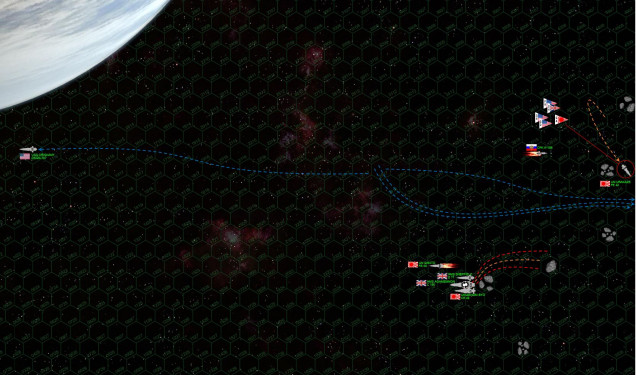 The Oriskany makes flank speed and races out of the battle area, using the planet’s gravity to assist her speed. She’s lost forward shields, even a single hit from a Ki-45 torpedo could end the ship forever. The rest of the fleet breaks off as well, after Spencer makes the grueling and difficult decision against an all-or-nothing gunnery and torpedo strike against the Agamemnon’s injured starboard quarter (they can’t hit her stern directly because her captain Lord Edward Cavendish) has screened his engines with proto-lunar debris directly astern). There’s a despairing attempt by the Marine fighters to “shoot down” IJN Urakaze, but their commander doesn’t realize that Urakaze has no forward shields and so attacks the stern. No appreciable damage is done. The Americans have LOST this battle, with two seemingly small but critical errors that largely threw away their edge in expertise and upgraded ships … instead making this a slugging match of weight against weight, a contest they could never win. For their part, the British and Japanese fought a cautious, reserved, and measured battle, using angles, distance, patience, and asteroid debris to negate American advantages in maneuverability.
The Oriskany makes flank speed and races out of the battle area, using the planet’s gravity to assist her speed. She’s lost forward shields, even a single hit from a Ki-45 torpedo could end the ship forever. The rest of the fleet breaks off as well, after Spencer makes the grueling and difficult decision against an all-or-nothing gunnery and torpedo strike against the Agamemnon’s injured starboard quarter (they can’t hit her stern directly because her captain Lord Edward Cavendish) has screened his engines with proto-lunar debris directly astern). There’s a despairing attempt by the Marine fighters to “shoot down” IJN Urakaze, but their commander doesn’t realize that Urakaze has no forward shields and so attacks the stern. No appreciable damage is done. The Americans have LOST this battle, with two seemingly small but critical errors that largely threw away their edge in expertise and upgraded ships … instead making this a slugging match of weight against weight, a contest they could never win. For their part, the British and Japanese fought a cautious, reserved, and measured battle, using angles, distance, patience, and asteroid debris to negate American advantages in maneuverability. 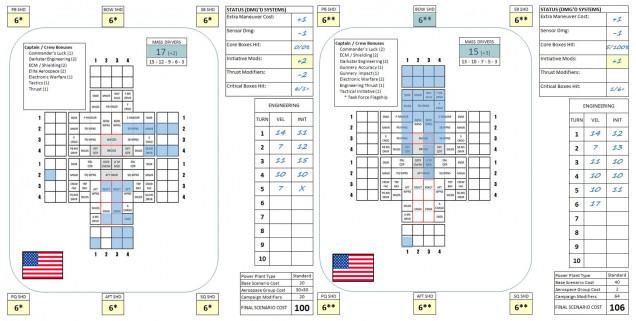 Here are the Warships Record Sheets (WRS) of the Marine carrier USS Tarawa (left) and the USS Oriskany (right). You can see where the Tarawa took the brunt of the Japanese and British cruiser fire on her starboard bow, then a fusillade of Ki-45 torpedoes astern. Then we have the Oriskany, who took every gun in the Renkei force … and at pretty close range as well. It’s amazing these ships didn’t explode, but again these ships have heavily upgraded ECM, gravitic shielding, and enhanced electronic warfare suites. At the end of the day they’re “just” destroyers, they’re just insanely fast, wicked accurate, and almost stealthy enough to serve as Romulan warbirds. :D I’m hoping this comparison also shows how ships can survive a LOT of damage (Oriskany remained operational), or be crippled by just a little. It’s all about WHERE the damage hits, and what systems go down. This means that tabletop tactics in range, angles, movement, and planning are crucial, as well as longer-term forethought when designing the warships themselves.
Here are the Warships Record Sheets (WRS) of the Marine carrier USS Tarawa (left) and the USS Oriskany (right). You can see where the Tarawa took the brunt of the Japanese and British cruiser fire on her starboard bow, then a fusillade of Ki-45 torpedoes astern. Then we have the Oriskany, who took every gun in the Renkei force … and at pretty close range as well. It’s amazing these ships didn’t explode, but again these ships have heavily upgraded ECM, gravitic shielding, and enhanced electronic warfare suites. At the end of the day they’re “just” destroyers, they’re just insanely fast, wicked accurate, and almost stealthy enough to serve as Romulan warbirds. :D I’m hoping this comparison also shows how ships can survive a LOT of damage (Oriskany remained operational), or be crippled by just a little. It’s all about WHERE the damage hits, and what systems go down. This means that tabletop tactics in range, angles, movement, and planning are crucial, as well as longer-term forethought when designing the warships themselves.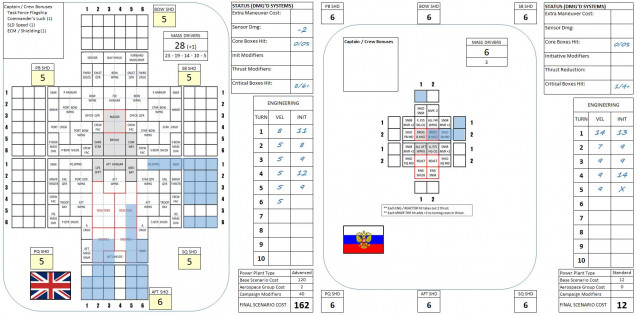 The mighty Agamemnon, where it took the full torpedo might of the Russo-American force … three times. Critically, however, note where the damage is on two sides. The first big slam on the starboard quarter is because the Russian torpedoes were just too far away to hit full astern along with the Americans. Put that starboard quarter damage on the aft facing instead, and this game is a shattering American victory. The second big pasting on the starboard quarter came when Damon maneuvered his cruiser to where I couldn’t get at his stern thanks to asteroids, timely turns, and distance. Then we have the K-56 torpedo corvette K-109, crippled by the pin-point guns on Rasmus’ light cruiser Sendai Byo. Of course, corvettes are murderously hard to hit, but once you do, it doesn’t take much because they’re so small.
The mighty Agamemnon, where it took the full torpedo might of the Russo-American force … three times. Critically, however, note where the damage is on two sides. The first big slam on the starboard quarter is because the Russian torpedoes were just too far away to hit full astern along with the Americans. Put that starboard quarter damage on the aft facing instead, and this game is a shattering American victory. The second big pasting on the starboard quarter came when Damon maneuvered his cruiser to where I couldn’t get at his stern thanks to asteroids, timely turns, and distance. Then we have the K-56 torpedo corvette K-109, crippled by the pin-point guns on Rasmus’ light cruiser Sendai Byo. Of course, corvettes are murderously hard to hit, but once you do, it doesn’t take much because they’re so small.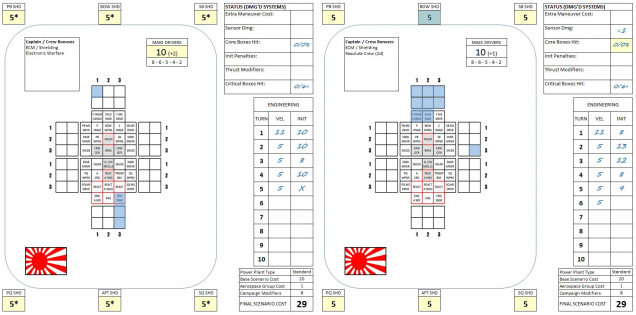 The two Japanese frigates. As if the Russo-American torpedo strike wasn’t a bad enough mistake on my part (if I’d waited until Turn 4 with that ordinance strike, I would’ve won hands down) … I then screwed up again on Turn 5 by forgetting that the Urakaze had NO FORWARD SHIELDS for that fighter strafing mission! Just three boxes of damage would have hit the bridge and crippled the ship in a miniature recreation of INS Executor’s end in Episode VI ROTJ. But even if I’d done this, the Americans still lose overall 113 to 61, a 13% victory. So this wouldn’t have changed the overall result, but it still bugs me when I make blatant rules mistakes like this.
The two Japanese frigates. As if the Russo-American torpedo strike wasn’t a bad enough mistake on my part (if I’d waited until Turn 4 with that ordinance strike, I would’ve won hands down) … I then screwed up again on Turn 5 by forgetting that the Urakaze had NO FORWARD SHIELDS for that fighter strafing mission! Just three boxes of damage would have hit the bridge and crippled the ship in a miniature recreation of INS Executor’s end in Episode VI ROTJ. But even if I’d done this, the Americans still lose overall 113 to 61, a 13% victory. So this wouldn’t have changed the overall result, but it still bugs me when I make blatant rules mistakes like this.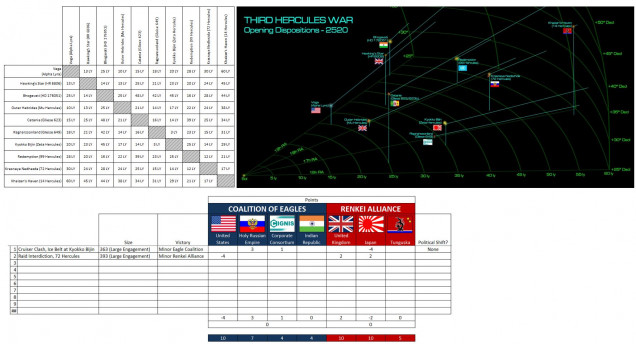 So UNLIKE PREVIOUS Darkstar games, this is part of a FULL CAMPAIGN we are tracking with actual astrophysical data, locations of all ships, damage / status of ships, superluminal transit times, and communication times. There is no FTL comm in the Darkstar ‘verse, remember – courier ships only, which admittedly travel at x1000 c, but that’s still days or weeks between some of these star systems. So Damon and Rasmus have won in 72 Hercules. They can either choose to remain in that system with the ships they have (ships that are NOT crippled can make repairs where they are, crippled ships must return to port and make repairs there). The risks are: My Russian fleet (admittedly reduced) is still lurking in the outer ice belt of Rasmus’ Zeta Hercules system where we won previously. And we calculated the transit times and the repair times for Task Force Oriskany, and even with the Tarawa crippled, we can be fully assembled back at Alpha Lyra (Vega) in 26 days. (just 8 days to cross 30 light years … yes, these Americans are THAT fast), +12 internal damage boxes on USS Tarawa (x1.5 because she is CRIPPLED) = 8 + 18 = 26 days. And both Hawking’s Star and the Outer Hebrides are RIGHT THERE within easy striking distance of Vega. So Rasmus and Damon agree to take their win and pull out, back to Zeta Hercules and Outer Hebrides, respectively. As for the Russians, I left their decision to the dice (as I’m also campaign referee, I want to avoid meta-gaming). They rolled to pull the Admiral Lazarev cruiser group out of Zeta Hercules, given the new threat directly in Krasnaya Nadhezda. Remember how slow information transits between these star systems. All my Russians in Zeta Hercules know is that there’s been a raid in their home system and the Americans failed to stop it. By the time they hear that the British and Japanese have pulled OUT of 72 Hercules, the Russians are probably on their way back to redress the situation.
So UNLIKE PREVIOUS Darkstar games, this is part of a FULL CAMPAIGN we are tracking with actual astrophysical data, locations of all ships, damage / status of ships, superluminal transit times, and communication times. There is no FTL comm in the Darkstar ‘verse, remember – courier ships only, which admittedly travel at x1000 c, but that’s still days or weeks between some of these star systems. So Damon and Rasmus have won in 72 Hercules. They can either choose to remain in that system with the ships they have (ships that are NOT crippled can make repairs where they are, crippled ships must return to port and make repairs there). The risks are: My Russian fleet (admittedly reduced) is still lurking in the outer ice belt of Rasmus’ Zeta Hercules system where we won previously. And we calculated the transit times and the repair times for Task Force Oriskany, and even with the Tarawa crippled, we can be fully assembled back at Alpha Lyra (Vega) in 26 days. (just 8 days to cross 30 light years … yes, these Americans are THAT fast), +12 internal damage boxes on USS Tarawa (x1.5 because she is CRIPPLED) = 8 + 18 = 26 days. And both Hawking’s Star and the Outer Hebrides are RIGHT THERE within easy striking distance of Vega. So Rasmus and Damon agree to take their win and pull out, back to Zeta Hercules and Outer Hebrides, respectively. As for the Russians, I left their decision to the dice (as I’m also campaign referee, I want to avoid meta-gaming). They rolled to pull the Admiral Lazarev cruiser group out of Zeta Hercules, given the new threat directly in Krasnaya Nadhezda. Remember how slow information transits between these star systems. All my Russians in Zeta Hercules know is that there’s been a raid in their home system and the Americans failed to stop it. By the time they hear that the British and Japanese have pulled OUT of 72 Hercules, the Russians are probably on their way back to redress the situation. 









































































Great game and fun to for once fighting along the Royal Navy
Campaign play definitely provokes a different attitude, I was giving much more thought to defending myself and waiting for enemy errors than to risky offensive moves. The game was fun and worked out well but was only a whisker away from losing a heavy cruiser which was making me sweat. @oriskany, you definitely made the right call aborting the mission when you did because I think the close range drive by you contemplated could have been a bloodbath.